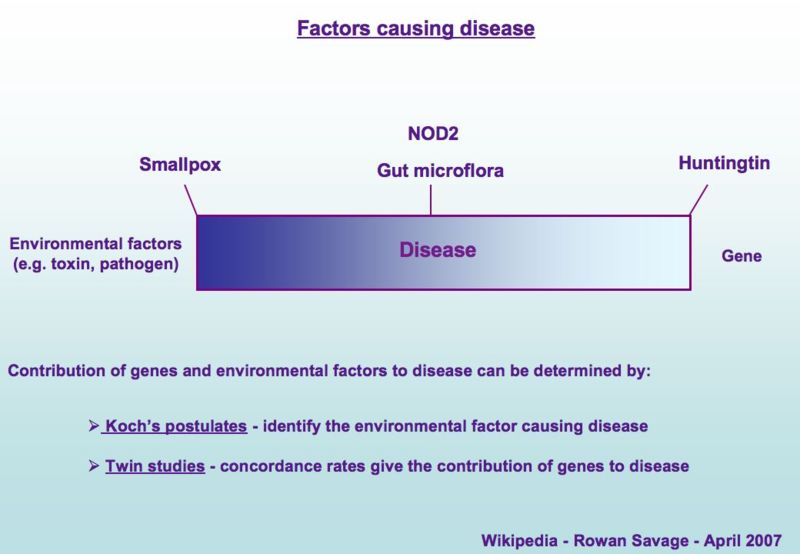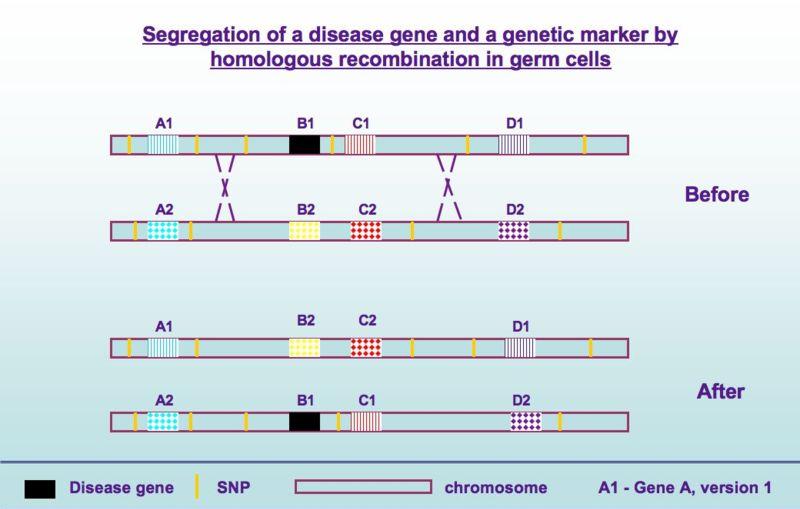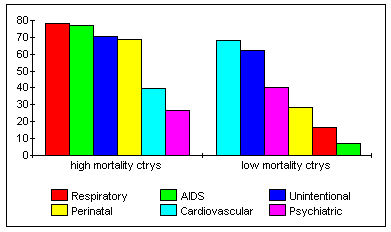Disease
|
WikiDoc Resources for Disease |
|
Articles |
|---|
|
Most recent articles on Disease |
|
Media |
|
Evidence Based Medicine |
|
Clinical Trials |
|
Ongoing Trials on Disease at Clinical Trials.gov Clinical Trials on Disease at Google
|
|
Guidelines / Policies / Govt |
|
US National Guidelines Clearinghouse on Disease
|
|
Books |
|
News |
|
Commentary |
|
Definitions |
|
Patient Resources / Community |
|
Directions to Hospitals Treating Disease Risk calculators and risk factors for Disease
|
|
Healthcare Provider Resources |
|
Causes & Risk Factors for Disease |
|
Continuing Medical Education (CME) |
|
International |
|
|
|
Business |
|
Experimental / Informatics |
Editor-In-Chief: C. Michael Gibson, M.S., M.D. [1]
Overview
A disease is an abnormal condition of an organism that impairs bodily functions. In human beings, "disease" is often used more broadly to refer to any condition that causes discomfort, dysfunction, distress, social problems, and/or death to the person afflicted, or similar problems for those in contact with the person. In this broader sense, it sometimes includes injuries, disabilities, disorders, syndromes, infections, isolated symptoms, deviant behaviors, and atypical variations of structure and function, while in other contexts and for other purposes these may be considered distinguishable categories.
While many diseases are biological processes with observable alterations of organ function or structure, others primarily involve alterations of behavior.
Classifying a condition as a disease is a social act of valuation, and may change the social status of the person with the condition (the patient). Some conditions (known as culture-bound syndromes) are only recognized as diseases within a particular culture. Sometimes the categorization of a condition as a disease is controversial within the culture.
Causes of disease
Many different factors intrinsic or extrinsic to a person (or plant or animal) can cause disease. Examples of intrinsic factors are genetic defects or nutritional deficiencies. An environmental exposure, such as second-hand smoke is an example of an extrinsic factor. Many diseases result from a combination of intrinsic and extrinsic factors. For many diseases a cause cannot be identified.
There are many different factors that can cause disease. These can be broadly categorized into the following categories like social, psychological, chemical and biological. Some factors may fall into more than one category. Biochemical causes of disease can be considered as a spectrum where at one extreme disease is caused entirely by genetic factors (e.g. CAG repeats in the Huntingtin gene that causes Huntington's Disease) and at the other extreme is caused entirely by environmental factors. Environmental factors include toxic chemicals (e.g. acetaldehyde in cigarette smoke and dioxins released from the breakdown of Agent Orange) and infectious agents (e.g. smallpox virus and poliovirus). In between these extremes genes (e.g. NOD2/CARD15) and environmental factors (e.g. Gut microbiota) interact to cause disease, as seen for example in the inflammatory bowel disease Crohn's Disease (Fig 1, right).

Absence of the genetic or environmental factors in this case results in disease not being manifest. Koch's postulates can be used to determine whether a disease is caused by an infectious agent.
To determine whether a disease is caused by genetic factors, researchers study the pattern inheritance of the disease in families. This provides qualitative information about the disease (how it is inherited). A classic example of this method of research is inheritance of hemophilia in the British Royal Family. More recently this research has been used to identify the Apoliprotein E (ApoE) gene as a susceptibility gene for Alzheimer's Disease, though some forms of this gene - ApoE2 - are associated with a lower susceptibility. To determine to what extent a disease is caused by genetic factors (quantitative information), twin studies are used. Monozygotic twins are genetically identical and likely share a similar environment whereas dizygotic twins are genetically similar and likely share a similar environment. Thus by comparing the incidence of disease (termed concordance rate) in monozygotic twins with the incidence of disease in dizygotic twins, the extent to which genes contribute to disease can be determined. Candidate disease genes can be identified using a number of methods. One is to look for mutants of a model organism (e.g. the organisms Mus musculus,Drosophila melanogaster, Caenhorhabditis elegans,Brachydanio rerio and Xenopus tropicalis) that have a similar phenotype to the disease being studied. Another approach is to look for segregation of genes or genetic markers (e.g. single nucleotide polymorphism or expressed sequence tag) (Fig. 2).

A large number of SNPs spaced throughout the genome have been identified recently in a large project called the HapMap project[1][2]). The usefulness of the HapMap project and SNP typing and their relevance to society was covered in the 27 October 2005 issue of the leading international science journal Nature (journal).
A large number of genes have been identified that contribute to human disease. These are available from the US National Library of Medicine, which has an impressive range of biological science resources available for free online. Amongst these resources is Online Mendelian Inheritance in Man - OMIM that provides a very, very comprehensive list of all known human gene mutations associated with, and likely contributing to, disease. Each article at OMIM is regularly updated to include the latest scientific research. Additionally, each article provides a detailed history of the research on a given disease gene, with links to the research articles. This resource is highly valuable and is used by the world's top science researchers.
Related concepts
The terms disease, disorder, medical condition are often used interchangeably. There is no agreed-upon universal distinction between these terms, though some people do make distinctions in particular contexts.
Medical usage sometimes distinguishes a disease, which has a known specific cause or causes (called its etiology), from a syndrome, which is a collection of signs or symptoms that occur together. However, many conditions have been identified, yet continue to be referred to as "syndromes." Furthermore, numerous conditions of unknown etiology are referred to as "diseases" in many contexts. Refractory diseases do not respond to therapy by overcoming the resistance to drugs.
Illness, although often used to mean disease, can also refer to a person's perception of their health, regardless of whether they in fact have a disease. A person without any disease may feel unhealthy and simply have the perception of having an illness. Another person may feel healthy with similar perceptions of perfectly good health. The individual's perception of good health may even persist with the medical diagnosis of having a disease; for example, such as dangerously high blood pressure, which may lead to a fatal heart attack or stroke.
Pathology is the study of diseases. The subject of systematic classification of diseases is referred to as nosology. Its cause is referred as its etiology. The broader body of knowledge about human diseases and their treatments is medicine. Many similar (and a few of the same) conditions or processes can affect non-human animals (wild or domestic). The study of diseases affecting animals is veterinary medicine.
Disease can be thought of as the presence of pathology, which can occur with or without subjective feelings of being unwell or social recognition of that state. Illness as the subjective state of "unwellness" can occur independently of, or in conjunction with, disease or sickness (with sickness the social classification of someone deemed diseased, which can also occur independently of the presence or absence of disease or illness (c.f. subjective medical conditions). Thus, someone with undetected high blood pressure who feels to be of good health would be diseased, but not ill or sick. Someone with a diagnosis of late-stage cancer would be diseased, probably feeling quite ill, and recognized by others as sick. A person incarcerated in a totalitarian psychiatric hospital for political purposes could arguably be then said to not be diseased, nor ill, but only classified as sick by the rulers of a society with which the person did not agree. Having had a bad day after a night of excess drinking, one might feel ill, but one would not be diseased, nor is it likely that a boss could be convinced of the sickness.
Transmission of disease
Some diseases such as influenza are contagious or infectious. Infectious diseases can be transmitted by any of a variety of mechanisms, including aerosols produced by coughs and sneezes, by bites of insects or other carriers of the disease, and from contaminated water or food (possibly by faeces or urine in the sewage), etc. Also, there are sexually transmitted diseases. When micro-organisms that cannot be spread from person to person might play a role, some diseases can be prevented with proper nutrition. Other diseases such as cancer and heart disease are not considered to be caused by infection. The same is true of mental diseases.
Social significance of disease
Living with disease can be very difficult. The identification of a condition as a disease, rather than as simply a variation of human structure or function, can have significant social or economic implications. The controversial recognitions as diseases of post-traumatic stress disorder, also known as "Soldier's heart," "shell shock," and "combat fatigue;" repetitive motion injury or repetitive stress injury (RSI); and Gulf War syndrome has had a number of positive and negative effects on the financial and other responsibilities of governments, corporations and institutions towards individuals, as well as on the individuals themselves. The social implication of viewing aging as a disease could be profound, though this classification is not yet widespread.
A condition may be considered to be a disease in some cultures or eras but not in others. Oppositional-defiant disorder, attention-deficit hyperactivity disorder, and, increasingly, obesity, are conditions considered to be diseases in the United States and Canada today, but were not so-considered decades ago and are not so-considered in some other countries. Lepers were a group of afflicted individuals who were historically shunned and the term "leper" still evokes social stigma. Fear of disease can still be a widespread social phenomena, though not all diseases evoke extreme social stigma.
Sickness confers the social legitimization of certain benefits, such as illness benefits, work avoidance, and being looked after by others. In return, there is an obligation on the sick person to seek treatment and work to become well once more. As a comparison, consider pregnancy, which is not a state interpreted as disease or sickness by the individual. On the other hand, it is considered by the medical community as a condition requiring medical care and by society at large as a condition requiring one's staying at home from work.
Global Disease Burden
This chart, compiled in 2002 from the World Health Organization's Global Burden of Disease shows an overview of the impact of various classifications of disease, segregated by regions with low and high mortality:
References
- ↑ McVean G, Spencer CC, Chaix R (2005). "Perspectives on human genetic variation from the hapmap project". PLoS Genet. 1 (4): e54. PMID 16254603.This review is free of charge
- ↑ Skelding K.A., Gerhard GS, Simari RD, Holmes DR Jr (2007). "The effect of HapMap on cardiovascular research and clinical practice". Nat Clin Pract Cardiovasc Med. 4 (3): 136–142. PMID 17330125.
External links
| File:Wiktionary-logo-en-v2.svg | Look up disease in Wiktionary, the free dictionary. |
- Health Topics, MedlinePlus descriptions of most diseases, with access to current research articles.
- Center for Disease Control Health Topics A-Z, fact sheets about many common diseases
- imedblog, Latest disease and medical news
- National Organization for Rare Disorders Extensive, useful information on rare diseases.
- The Merck Manual, detailed description of most diseases, freely searchable online.
- OMIM Online Mendelian Inheritance in Man - The best web resource for information on genes that cause disease.
- NLM US National Library of Medicine - The most comprehensive database of top quality science information on the web
- Eurekalert A digest of the latest science news.
- Answers to several questions of curious kids related to diseases
- Naked Scientists Podcast A 1hr fun-loving science radio program.
- Nature Podcast A 30 minute digest of the very latest science research reported in the journal Nature.
- HapMap Online
See also
- Category:Diseases (Diseases with Wikipedia articles, organized by type)
- List of childhood diseases
- List of eponymous diseases
- List of diseases for a list of 6000+ diseases, many very rare.
- List of diseases caused by insects
- List of genetic disorders
- List of environment topics
- List of ICD-9 codes
- List of ICD-10 codes
- List of skin diseases
- List of infectious diseases
- Diagnosis
- Disease management (health)
- Epidemic
- Foodborne illness
- Local disease
- Localized disease
- Syndemic
- Systemic disease
- Illness
- Palliative care
- Transmission
- Globalization and Disease
- Healthcare
- Waterborne diseases
Template:Skin and subcutaneous tissue symptoms and signs Template:Nervous and musculoskeletal system symptoms and signs Template:Urinary system symptoms and signs Template:Cognition, perception, emotional state and behaviour symptoms and signs Template:Speech and voice symptoms and signs Template:General symptoms and signs
als:Krankheit ar:مرض ast:Enfermedá zh-min-nan:Pīⁿ br:Kleñved bg:Болест ca:Malaltia cs:Nemoc da:Sygdom de:Krankheit et:Haigus eo:Malsano eu:Gaixotasun fa:بیماری io:Morbo id:Penyakit ia:Maladia is:Sjúkdómur it:Malattia he:מחלה la:Morbus lv:Slimība ln:Bokɔnɔ hu:Betegség ml:രോഗം ms:Penyakit nl:Ziekte no:Sykdom nn:Sjukdom ps:ناروغي sq:Sëmundja simple:Disease sk:Choroba sl:Bolezen fi:Sairaus sv:Sjukdom tl:Karamdaman th:โรค ur:مرض yi:קרענק
